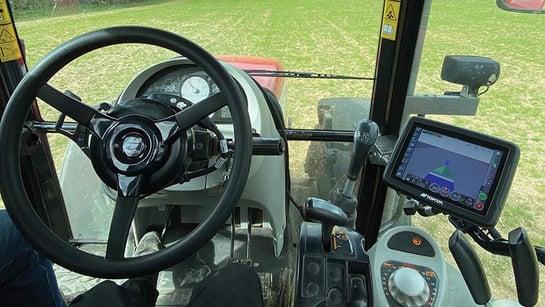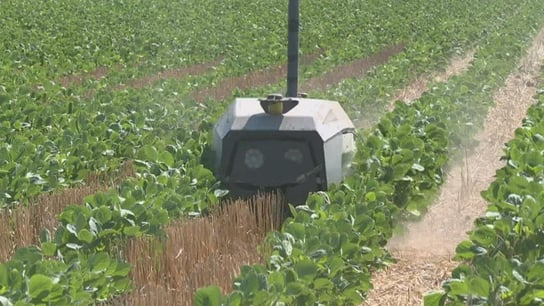What’s New in Robotics? 24.11.2023

Posted on Nov 24, 2023 7:59 AM. 8 min read time
News briefs for the week take a look at UPS’s new warehouse that greatly maximizes the headcount of robots over workers, decades-old farm tractors modernized for autonomy via a retrofit, WeedBot’s “weeding as a service” that eliminates herbicides, the U.S. Navy leveraging Gecko Robotics to build new ships, and robots and AI for 2024 spearheading a “Productivity Mega Cycle”.
UPS says more robots, fewer workers
UPS Supply Chain Solutions, Big Brown’s warehousing, distribution, customs clearance, global freight forwarding, and logistics services division, which is different from the e-commerce package delivery side of United Parcel Service (UPS), just opened its newest and largest warehouse, a 20-acre facility in Louisville, Kentucky.
Striking feature: Lots of robots, fewer workers. In fact, the machine-to-human ratio is 15 to 1. Eventually, the tally will be 3,000 robots and 200 workers. And it’s not just a freakish warehouse anomaly. Quite to the contrary, this is the future of all logistics, all warehouses.
 In fact, UPS Velocity, the e-commerce package delivery folks, are also on the same “robots in/workers out” trajectory. These goods-to-person operations use on the order of 700 robots, but as Big Brown says: “We plan to triple [robots] across our network in the next year. Goods-to-person technology uses AI to arrange space for optimal speed and can even pick up inventory.”
In fact, UPS Velocity, the e-commerce package delivery folks, are also on the same “robots in/workers out” trajectory. These goods-to-person operations use on the order of 700 robots, but as Big Brown says: “We plan to triple [robots] across our network in the next year. Goods-to-person technology uses AI to arrange space for optimal speed and can even pick up inventory.”
Bill Seward, president of UPS Supply Chain Solutions, says of the $79 million warehouse: “It’s a linchpin of our strategy. It’s important to be able to deliver best-in-class cost and best-in-class service for your customers.”
It’s a trend that seems to be working. “Sales at UPS’s logistics business have climbed 11% in the first nine months of this year even as overall sales for Supply Chain Solutions, which also includes freight forwarding and truck brokerage, fell more than 22% amid a cargo slump.”
More to the point of future direction, “Large operators, including UPS and GXO Logistics Inc., are using the draw of automation to grab market share from companies that run older facilities and count more on human workers.”
Transport Topics News reports that Seward said the robots increase the speed and accuracy of processing orders, keep better track of inventory and save space by fetching products that are stacked higher in the building.
Old tractors learn new automation tricks
Farm tractors and harvesters built in the 1970s are suddenly learning new tricks on how to operate autonomously, like steering for themselves.
 These days, with sliding commodity markets showing corn and wheat futures down 29%, while soybean prices have fallen 14%, it’s a must for farmers to get more cost-effective. For wheat, canola, and lentils farmer Nick Welker, retrofitting his 52-year old tractor instead of buying automated gear from the likes of John Deere is the difference between spending $700,000 for new as opposed to a retrofit for $20,000.
These days, with sliding commodity markets showing corn and wheat futures down 29%, while soybean prices have fallen 14%, it’s a must for farmers to get more cost-effective. For wheat, canola, and lentils farmer Nick Welker, retrofitting his 52-year old tractor instead of buying automated gear from the likes of John Deere is the difference between spending $700,000 for new as opposed to a retrofit for $20,000.
Farm machinery manufacturers Agco and CNH Industrial are taking heed and are expanding their lines of retrofit products “to turn equipment already in service into smart machines that can plant seeds, spray crops and perform other tasks with more precision and automation.”
Even market leader John Deere, with nearly two-thirds of the market for new high-horsepower tractors in the U.S. and Canada, has begun selling retrofits.
 Agco reasons that with just 7% of farmers globally replacing their equipment in a given year, that leaves 93% of farmers still using older models. That whopping 93% are potential customers for upgrades and retrofits, which, according to Agco, is a $150 billion-a-year market opportunity.
Agco reasons that with just 7% of farmers globally replacing their equipment in a given year, that leaves 93% of farmers still using older models. That whopping 93% are potential customers for upgrades and retrofits, which, according to Agco, is a $150 billion-a-year market opportunity.
“Most farm equipment has a useful life of about 17 years. Over that time, technology shifts so much. But the equipment is only used for a small part of the year,” said Eric Hansotia, chief executive officer of Agco, the maker of Fendt and Massey Ferguson machinery.”
To capitalize on the opportunity, Agco paid $2 billion for an 85% stake in Colorado-based Trimble’s agriculture technology business. Trimble’s software system for self-steering, precision spraying, data management and equipment monitoring Agco sees as a great match for its bolt-on retrofit offerings.
WeedBot: saving crops without herbicides
Any means of saving crops from weeds without the use of herbicides is a wallet-pleasing, near-miracle in the eyes of most farmers. Automate such a solution with an unattended robot like WeedBot, from Kansas-based Greenfield Robotics, and there’s a multi-million  dollar market at the ready to assist or replace the global $39 billion spent annually on herbicides.
dollar market at the ready to assist or replace the global $39 billion spent annually on herbicides.
Weeds are voracious, nutrient-stealing, sun-stealing crop killers. Of the current total global grain production of ~2.1 billion metric tons, better than 10% or ~200 million metric tons, is annually lost to weeds. Kansas farmer Clint Brauer saw “Marestail and pigweed wreak havoc on his soybean fields, and realized there was no way to stay ahead of weeds on broadacre crops without relying on chemicals.”
For example, yield loss with no weed control in corn is 52% and in soybean is 49.5% without herbicides.
Brauer’s search for an alternative to chemical control resulted in an experiment with a prototype using rotary mowers with the blades set about a half inch or lower above the weeds. It worked. Brauer and two friends then launched Greenfield Robotics.
 “Weighing in at about 350 pounds, the machine is 24 inches wide and 3 feet long, travels at about 3.5 mph, and is water-resistant. The robot can cover about an acre per hour.
“Weighing in at about 350 pounds, the machine is 24 inches wide and 3 feet long, travels at about 3.5 mph, and is water-resistant. The robot can cover about an acre per hour.
“On a 100-acre field, we would deploy a fleet of 10 WeedBots,” Brauer says. “In 10 hours, we would be done weeding the field.”
Greenfield Robotics launched as a robot as a service business model, with the WeedBot’s services costing about $35 per acre, and usually weed up to three times per season depending on the climate.
By comparison, herbicides cost a farmer on average $95 per acre, with the typical range being $65-$120 per acre.
At less than half price, seems WeedBot as a service is a bargain, plus it increases productivity and saves on a farm’s labor costs.
U.S. Navy enlists Gecko Robotics
Pittsburgh-based Gecko Robotics (founded 2013) is on a mission, say the co-founders, Jake Loosararian and Troy Demmer, to utilize its wall-climbing robots, sensors, and AI-powered data platform to provide customers a unique window into the current and future health of their physical assets.
 “Our nation’s most critical infrastructure—from pipelines and industrial plants to ships and suspension bridges—is slowly going to pieces, leading the American Society for Civil Engineers to give our infrastructure a C-minus on its most recent report card,” writes the Wall Street Journal.
“Our nation’s most critical infrastructure—from pipelines and industrial plants to ships and suspension bridges—is slowly going to pieces, leading the American Society for Civil Engineers to give our infrastructure a C-minus on its most recent report card,” writes the Wall Street Journal.
How to tell where problems are or are going to be is difficult and time-consuming. Gecko Robotics, however, lets its robots seek out and find those problems. The robots are quick and thorough, which leads to faster, better repairs.
Then the U.S. Navy came calling with a problem. This time, it wasn’t for the robots to climb and scout existing infrastructure, but rather, the Navy was looking for help with new construction of its vessels. Specifically, to help the Navy’s first Columbia-class submarine to be ocean ready by 2027. “As it turned out, Gecko’s dexterous robots — which generate millions of data points as they traverse industrial equipment checking for cracks, corrosion and other damage —could offer an ideal solution.
Gecko’s expertise in a proof-of-concept demonstration proved to be the clincher in being awarded a Navy contract.
Although Gecko has previously focused on the private sector, gathering data from nearly 70,000 commercial assets across the globe, including ships, factories and power plants, now, happily, it seems that military applications have increasing promise.
Robots and the “Productivity Mega Cycle” for 2024
For the investing crowd looking to get a feel for 2024, Investing Haven is out claiming that next year AI & Robotics Stocks Set To  Outperform the Market In 2024. Which, of course, would be reason to cheer for the entire robotics and automation industries.
Outperform the Market In 2024. Which, of course, would be reason to cheer for the entire robotics and automation industries.
The reasoning is because of the convergence of robotics with artificial intelligence in what Investing Haven refers to as “The Productivity Mega Cycle, a confluence of technological advancements and economic evolution that’s reshaping industries.”
“The core driver,” says Investing Haven, “is the integration of AI and robotics, propelling businesses towards unprecedented efficiency. AI-driven automation optimizes processes, reduces costs, and enhances decision-making. For investors, understanding this cycle is not just about technology; it’s recognizing how businesses leveraging AI will outperform, making AI-centric investments a key component of their strategy and portfolio 2024.”
Okay, now you know.


Leave a comment